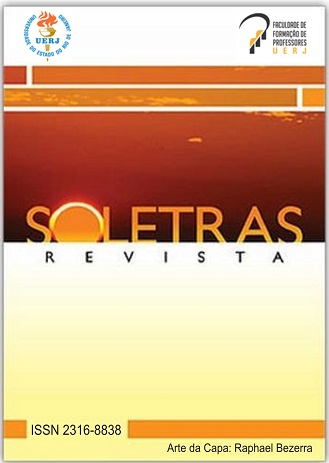Anchieta e a chegada da metalinguagem ao Brasil: uma análise ecolinguística e historiográfica dos conceitos de nome e de verbo na Arte de gramática da língua mais usada na costa do Brasil (1595)
DOI:
https://doi.org/10.12957/soletras.2025.87651Palavras-chave:
Gramaticografia, Sílaba, AnchietaResumo
O tema do artigo é a análise da chegada da metalinguagem ao Brasil, na Arte de gramática da língua mais usada na costa do Brasil (Anchieta, 1990 [1595]), do missionário jesuíta e humanista do Renascimento S. José de Anchieta (1534 – 1597), cuja obra gramatical pode ser considerada a pedra angular da gramaticografia no Brasil. O fato de a gramática tratar de uma língua indígena pode ser objeto da política linguística da Década Internacional das Línguas Indígenas 2022 – 2032 da UNESCO e das reflexões ecológicas e culturais da encíclica papal Laudato Si’ sobre o cuidado da casa comum. Para estabelecer uma análise da metalinguagem empregada por Anchieta em sua gramática, selecionamos dois conceitos oriundos da tradição gramatical greco-latina, o conceito de nome e de verbo, que foram adaptados para a descrição da língua tupinambá. Apresentamos o debate teórico de como os conceitos de nome e de verbo foram adaptados pelo gramático quinhentista na descrição da língua indígena.
Downloads
Publicado
Edição
Seção
Licença
A aprovação dos artigos implica a cessão imediata e sem ônus dos direitos de publicação nesta revista. O(s) autor(es) autoriza(m) ao Programa de Pós-graduação em Letras e Linguística (PPLIN) a reproduzi-lo e publicá-lo na revista SOLETRAS, entendendo-se os termos “reprodução” e “publicação” conforme definição do artigo 5° da Lei 9610/98. O(s) autor(es) continuará(rão) a ter os direitos autorais para publicações posteriores. O artigo poderá ser acessado pela rede mundial de computadores (http://www.e-publicacoes.uerj.br/index.php/soletras), sendo permitidas, a título gratuito, a consulta e a reprodução de exemplar do artigo para uso próprio de quem o consulta. Casos de plágio ou quaisquer ilegalidades nos textos apresentados são de inteira responsabilidade de seus autores.



